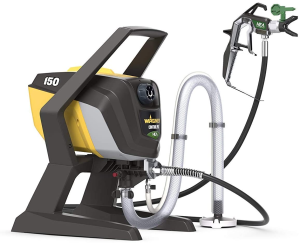
Actually, you usually don’t need to. Airless sprayers generally work best with thicker paints. This means you ofen skip thinning the paint beforehand. These sprayers are designed to handle thick latex primers and other paints without needing to be thinned. Before starting, always strain the paint. This removes any dust or hardened paint particles. If you’re using an HVLP sprayer or a small airless sprayer with less than 3,000 PSI, thinning paint is typically needless.
When is the Paint is Too Thin?
To thin acrylic or latex paints, start with ½ cup of water and mix thoroughly. If you’ve added too much water and the paint is too runny, it’s unusable. Gradually add paint back into the bucket, beginning with ½ cup. Mix well, and if needed, slowly add more water until you reach the desired consistency, stirring constantly. The paint should flow smoothly and evenly.
How To Thin Paints For Spraying?
Diffrent paint types often require unique thinning approaches. This section explores thinning methods for common paints used with sprayers. While not always needed for airless sprayers, thinning can be beneficial for HVLP models or compact airless sprayers with lower pressure. Using thinned paint can improve the paint job, potentially saving both money and effort.
When thinning latex paints, a 10% reduction is generally recommended. this is easily achieved by adding water. A common guideline is 1/2 cup of water per gallon of paint. However, you might need slightly more water when using an HVLP sprayer. For specific spray equipment, thinning by 20% or even 30% might be necessary. To thin the paint, use a separate container. Add the correct amount of water and mix thoroughly until the consistency is uniform. Avoid altering the paint directly in the original bucket.
Conversely, when thinning oil-based paints, carefully review the specific paint’s instructions. This ensures you achieve the optimal thinning ratio. For most small sprayers, a 10% thinning is usually sufficient. Use appropriate mineral spirits or thinners. Always adhere to the manufacturer’s guidelines to use the correct materials. Similar to latex paint, mix the required amounts of mineral spirits and paint in a large container. Then, thoroughly combine using a stirring spatula.
When to use a Paint Conditioner?
Many users have found success using Floetrol with latex paint.Floetrol is a paint conditioner, not a thinner. Paint conditioners help you paint in challenging conditions.For example, they are useful when it’s very humid outside. Using a sprayer in humid weather can cause latex paint to dry too quickly. This is not ideal when working with latex paint.
Floetrol makes paint flow smoother, especially in spray guns, and works well in any weather. Remember, Floetrol enhances paint, it’s not a thinner.It makes the paint act like oil-based paints, improving its flow. If you only need to thin the paint,use water as usual.
Why is it Suggested to Use an Airless Sprayer?
This equipment excels for extensive painting projects demanding a flawless finish. Designed for large tasks, it ensures even paint request. Available in two sizes, these applicators handle thick, unthinned paints, simplifying and accelerating work. It’s the perfect tool for quickly completing considerable painting jobs.
What is the best Ratio of Paint to Thinner for a Spray Gun?
For newcomers to spraying and painting, a primary question is often about thinning paint for spray guns. We’ll simplify this by focusing on two common spray systems and two paint types.
High-volume, low-pressure (HVLP) sprayers and airless sprayers are popular choices for modern interior decorating. Although these spray devices operate differently, both are commonly used for applying paint during home renovations.
Airless paint sprayers are incredibly powerful tools. They can spray coatings at pressures exceeding 2000 psi. This high pressure eliminates the need for compressed air. Paint is forced through a small nozzle, atomizing it into a fine mist. Airless sprayers can handle a wide range of materials, frequently enough without requiring any thinning.
Airless sprayers excel at thinning paint without compromising its quality. Many paints lose key properties when thinned. Generally, paints fall into two categories: enamel and acrylic.
Emulsion paints excel on both ceilings and walls. Even when thinned, they perform exceptionally well. Actually, thinning frequently enough improves spray application. For final emulsion coats, dilute the paint by 10% to 20%, following the manufacturer’s guidelines. For a 5-liter container, this means adding up to 1 liter of water.
Always dilute the emulsion slightly, unless applying it to bare concrete. For optimal airless sprayer application, begin by thinning the emulsion by at least 10%.
next, consider wood finishing paints. Most satin finishes are typically water-based. When spraying glossy paint on furniture, thinning isn’t usually needed. An airless sprayer can easily apply water-based sheen. Thinning could cause issues like shine erosion or streaks. Generally, never dilute paint before using an airless sprayer on wood.
